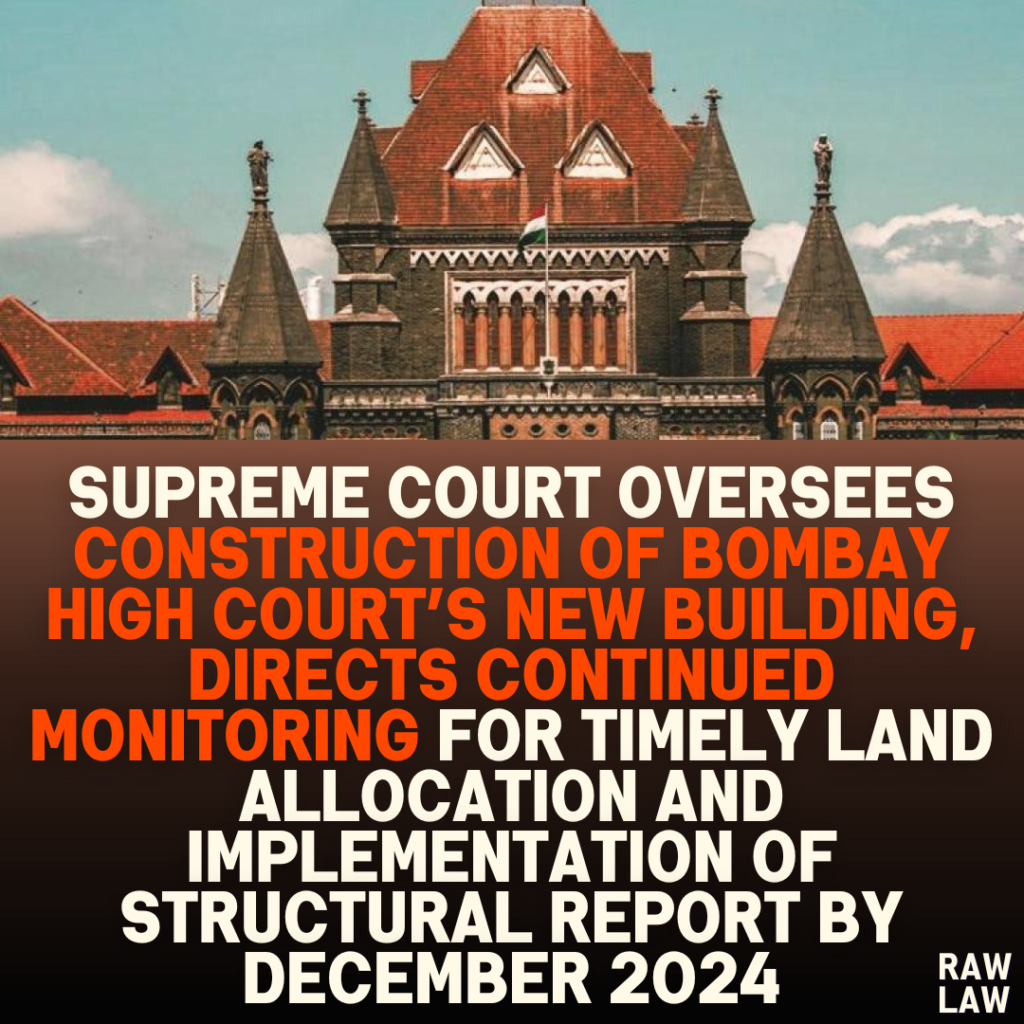Court’s Decision: The Supreme Court, while hearing the petition regarding the construction of a new building for the Bombay High Court, provided key directives to ensure timely progress. The Court acknowledged the ongoing efforts and directed the monitoring committee to oversee further developments. The Court adjourned the matter to January 16, 2025, requiring an updated status report from the concerned authorities. The Court also emphasized the importance of continued supervision by the monitoring committee of the Bombay High Court to ensure deadlines are met.
Facts: The petition concerned the heritage building of the Bombay High Court and the allocation of additional lands for its new building. During the hearing, the Court was apprised of the current status of the project by the Advocate General of Maharashtra. The submissions before the Court highlighted various aspects of the construction process, including land allocation, appointment of a Project Management Consultant (PMC), and the ongoing structural evaluation of certain buildings within the High Court precinct.
Issues:
- Whether the State of Maharashtra is adhering to the timeline for the construction of the new High Court building.
- Whether additional lands for the new building have been appropriately allocated.
- Whether the structural issues of existing buildings within the precinct, such as the PWD building, are being addressed.
Petitioner’s Arguments: The petition, moved suo moto by the Court, raised concerns regarding the delay in the construction of the new Bombay High Court building and the proper allotment of land for the project. The Court acted in its own capacity to oversee the progress and ensure compliance with the necessary timelines.
Respondent’s Arguments: The Advocate General of Maharashtra, representing the State, informed the Court that the next tranche of land for the High Court’s new building would be made available by December 2024. Furthermore, expressions of interest had been solicited from architects, and a PMC would be appointed shortly. Regular monitoring meetings were being held, with the next meeting scheduled for November 12-13, 2024. However, the possession of the Air India building, intended for a proposed Mediation Centre, was still pending.
Analysis of the Law: The Supreme Court, while acting within its jurisdiction to monitor infrastructure projects affecting judicial institutions, emphasized the need for timely progress on the construction of the Bombay High Court building. The Court’s intervention aims to prevent unnecessary delays in the allotment of lands and the construction process, invoking its authority to ensure the administration of justice is not hindered by infrastructural deficiencies.
Precedent Analysis: In previous matters concerning judicial infrastructure, the Supreme Court has actively monitored construction projects to avoid delays. The current approach aligns with earlier decisions where the Court has taken a proactive role in ensuring that projects related to the judiciary are executed promptly, thus maintaining the efficiency of the judicial process.
Court’s Reasoning: The Court acknowledged that while progress had been made, certain key aspects such as the transfer of the Air India building were yet to be resolved. The Court directed the monitoring committee to continue overseeing the project and emphasized that any delays in the project could not be excused. It reiterated the importance of adhering to the timeline, specifically the December 2024 deadline for land availability. The structural report for the PWD building, once received, would also need to be implemented without delay.
Conclusion: The Supreme Court adjourned the matter to January 16, 2025, with instructions for an updated status report on the construction of the new High Court building. The Court highlighted the necessity of regular monitoring to ensure that deadlines, including the availability of land and the appointment of a PMC, are met.
Implications: The Court’s active role in overseeing the construction of the Bombay High Court building underscores the importance it places on judicial infrastructure. The involvement of the highest judiciary ensures that the project remains on track and that any further delays are promptly addressed. This case may serve as a precedent for the Court’s proactive involvement in ensuring timely completion of critical infrastructure projects related to the judiciary.




Pingback: Gauhati High Court Acquits Driver Convicted for Narcotic Transportation, Citing Procedural Lapses in Seizure, Lack of Senior Authorization, and Non-Compliance with NDPS Act Provisions - Raw Law